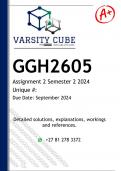GGH2605
Assignment 2 Semester 2 2024
Unique #:
Due Date: September 2024
Detailed solutions, explanations, workings
and references.
+27 81 278 3372
, QUESTION 1 (2 ANSWERS PROVIDED)
Introduction
The precautionary principle, a guiding framework in environmental policy,
emphasizes taking preventative action in the face of uncertainty to avoid potential
harm to the environment and human health. In South Africa, this principle has been
applied in various situations to mitigate risks associated with environmental
degradation. Drawing on the case studies presented by Kriebel et al. (2001), this
essay will explore a situation within South Africa where the precautionary principle
has influenced both policy and human behavior. The focus will be on the
implementation of regulations to reduce air pollution from industrial emissions in
the Gauteng province. The effectiveness of these policies will be critically evaluated
concerning human behavior and their broader environmental impact.
The Situation: Air Pollution Control in Gauteng
Gauteng, the economic hub of South Africa, is characterized by high levels of
industrial activity, which contributes significantly to air pollution. Recognizing the
potential health risks posed by airborne pollutants, the South African government,
guided by the precautionary principle, implemented stringent air quality regulations.
These regulations aimed to reduce emissions of harmful substances such as sulfur
dioxide (SO2), nitrogen oxides (NOx), and particulate matter (PM) from industrial
sources. The Air Quality Act of 2004 and subsequent amendments in 2010
represent the legal framework through which these controls were enforced
(Department of Environmental Affairs, 2010).
The implementation of these regulations required industries to adopt cleaner
technologies and reduce emissions, even in cases where the full extent of the
pollutants' harm was not entirely known. This preemptive approach was driven by
concerns about the long-term effects of air pollution on public health, particularly
respiratory and cardiovascular diseases, which were on the rise in heavily
industrialized areas.
Critical Evaluation of Policy Effectiveness
Human Behavioral Responses
Varsity Cube 2024 +27 81 278 3372




